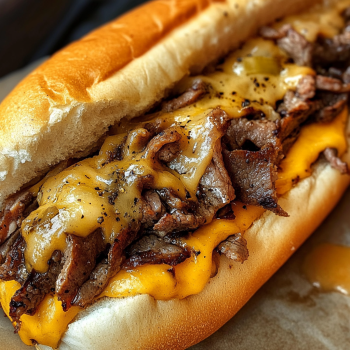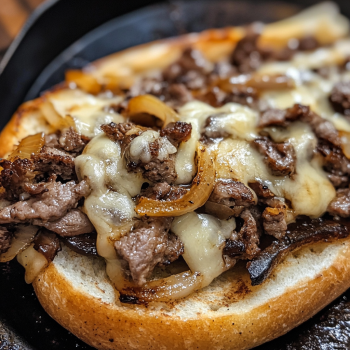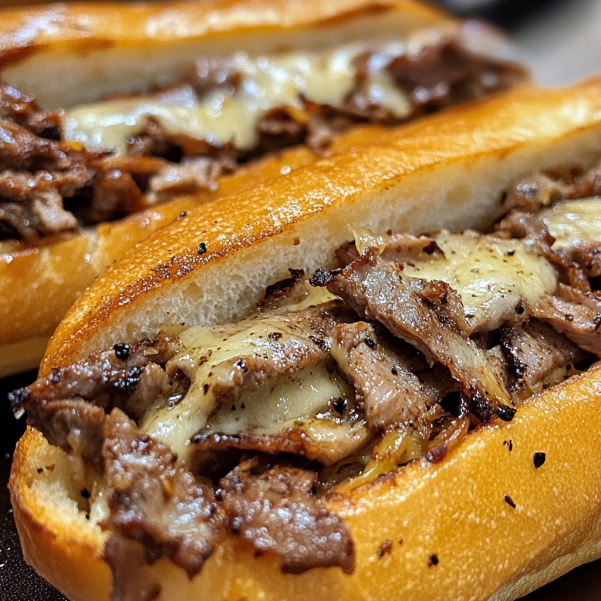What is a Philly Cheesesteak?
The Philly cheesesteak is more than just a meal—it’s an experience. Known for its combination of thinly sliced beef, melty cheese, and soft hoagie rolls, this sandwich has captured the hearts (and taste buds) of people everywhere. But what exactly makes it special?
The Iconic Sandwich of Philadelphia
Born in the city of Philadelphia, the Philly cheesesteak has become synonymous with the local food culture. It’s not just about the ingredients; it’s about tradition. The sandwich typically consists of thinly sliced ribeye steak cooked on a flat-top grill and topped with cheese, often Cheese Whiz, provolone, or American cheese. Add a freshly baked hoagie roll, and you’ve got the foundation of a classic.
A Brief History of the Philly Cheesesteak
The origins of the Philly cheesesteak date back to the 1930s. Legend has it that Pat Olivieri, a hot dog vendor in South Philadelphia, decided to throw some beef on his grill one day. He stuffed the cooked meat into an Italian roll, and as they say, the rest is history. A cab driver passing by caught a whiff and asked for one himself, and soon enough, Olivieri’s creation gained a loyal following
.
What started as a simple beef sandwich quickly evolved into the cheesesteak we know today. Cheese was added later, and debates still rage on whether Cheese Whiz, provolone, or American cheese is the best choice. Regardless of preference, this sandwich has become a staple of Philadelphia, with Pat’s King of Steaks and Geno’s Steaks leading the cheesesteak rivalry that draws crowds from all over.
Why It’s Popular Worldwide
The Philly cheesesteak may have its roots in Philadelphia, but its appeal knows no bounds. What makes this sandwich so loved is its simplicity and versatility. With variations popping up across the country, from cheesesteak pizzas to vegetarian versions, it’s clear that this sandwich can adapt while maintaining its authentic essence
.
Ingredients for an Authentic Philly Cheesesteak
To recreate a Philly cheesesteak that tastes like it came straight from South Philly, choosing the right ingredients is essential. From the cut of meat to the type of cheese, each element plays a role in building the sandwich’s signature flavor. Let’s dive into the specifics so you can bring a little piece of Philadelphia to your kitchen.
Essential Ingredients
The ingredients for a Philly cheesesteak might seem straightforward, but their quality and preparation make all the difference. To get the authentic taste, these are the essentials you’ll need:
Best Cuts of Beef for Philly Cheesesteak
The foundation of a great Philly cheesesteak is the meat, and the best option is ribeye steak. Ribeye has the perfect balance of fat and tenderness, which gives the sandwich that juicy, flavorful bite that melts in your mouth
. For the best results, partially freeze the ribeye before slicing it paper-thin; this technique helps achieve the classic texture that makes the Philly cheesesteak iconic
.
If ribeye isn’t available, you can also use other cuts like top round, though it may not be as tender. Whichever you choose, ensure the meat is sliced as thinly as possible for that authentic feel.
The Perfect Cheese
The debate over the best cheese for a Philly cheesesteak is fierce. Traditionally, Cheese Whiz is the go-to choice for many, especially purists who crave the sandwich’s gooey, indulgent texture. However, other popular options include provolone and American cheese, each adding its unique flavor profile.
- Cheese Whiz: The classic option that offers a creamy, tangy taste.
- Provolone: For those who prefer a milder, slightly sharp flavor
.
- American Cheese: Melts perfectly and provides a smooth, mild taste that complements the steak.
The Right Bread
An authentic Philly cheesesteak needs a proper roll. Amoroso rolls are widely considered the gold standard for cheesesteaks in Philadelphia
. These hoagie rolls are soft yet sturdy enough to hold the steak, cheese, and toppings without falling apart. If you can’t find Amoroso rolls, any soft hoagie or sub roll will work as long as it has a similar texture.
Optional Add-ins
While the classic Philly cheesesteak keeps it simple with just steak, cheese, and onions, there are a few optional add-ins that can elevate the flavor:
- Sautéed Onions: Onions are a staple in traditional cheesesteaks, adding sweetness and depth. Thinly sliced and cooked until caramelized, they blend perfectly with the steak and cheese.
- Bell Peppers and Mushrooms: For a twist, you can add these veggies. They’re often included in variations of the cheesesteak, offering a bit of crunch and an extra layer of flavor
.
Step-by-Step Guide to Making a Philly Cheesesteak
Now that you’ve gathered the essential ingredients, it’s time to bring them together. Making an authentic Philly cheesesteak might sound daunting, but with a little preparation and a few key techniques, you can recreate this iconic sandwich in your kitchen. Follow this step-by-step guide to achieve that perfectly juicy, melty, and flavorful result.
Preparing the Steak
The heart of any good Philly cheesesteak is, of course, the steak. The key to getting that tender, melt-in-your-mouth texture is slicing the meat as thinly as possible.
How to Slice the Meat Thin
To achieve the thin slices needed for the perfect Philly cheesesteak, partially freeze the ribeye steak for about 30 minutes before cutting. This step firms up the meat, making it much easier to slice
. Use a sharp knife and aim for slices no thicker than paper. If slicing isn’t your strong suit, you can ask your butcher to do it for you. Alternatively, some grocery stores sell pre-sliced ribeye specifically for cheesesteaks.
Marinating and Seasoning
While some purists believe the steak doesn’t need much more than salt and pepper, others enjoy adding a bit of Worcestershire sauce to enhance the beef’s flavor. Marinate the thin slices in a simple mix of salt, pepper, and Worcestershire sauce for 10-15 minutes before cooking. This quick marinade adds a savory depth that complements the richness of the cheese
.
Cooking the Ingredients
Now that the steak is ready, it’s time to cook. The secret to a Philly cheesesteak lies in the technique—using a hot, flat-top griddle or cast iron pan ensures that the steak cooks quickly and stays tender.
Sautéing Onions and Vegetables
If you’re using onions (a must for the classic version!), start by heating a little oil on the griddle over medium-high heat. Add thinly sliced onions and cook until they’re soft and caramelized, about 5 minutes
. If you’re adding bell peppers or mushrooms, toss them in with the onions, stirring occasionally until they’re golden and tender. Remove the veggies from the griddle and set them aside.
Cooking the Steak on the Griddle
Increase the heat to high and add a bit more oil to the griddle. Place the thinly sliced steak on the hot surface, spreading it out in a single layer. Let the steak cook for 1-2 minutes without moving it to get a nice sear. Then, using a spatula, chop and flip the meat as it cooks. The goal is to break it into smaller pieces and cook it until it’s no longer pink—this should take about 3-4 minutes
.
Once the steak is almost done, add the sautéed onions (and any other veggies) back to the griddle. Mix them with the meat, combining all those flavors.
Assembling the Sandwich
The final step is putting everything together to create the perfect Philly cheesesteak.
Melting the Cheese
While the meat and veggies are sizzling, it’s time to add the cheese. You can either place the cheese directly on the meat mixture on the griddle or put it inside the hoagie roll before adding the meat. Allow the cheese to melt—if you’re using Cheese Whiz, simply drizzle it over the hot meat; if you prefer provolone or American cheese, cover the meat with a lid for a minute to trap the heat and help the cheese melt
.
Toasting the Hoagie Roll
A freshly toasted hoagie roll can make a big difference. Split the roll, brush it lightly with butter (optional), and place it face down on the griddle for a minute until it’s golden and crisp. This step adds a satisfying crunch and keeps the bread from getting soggy once you pile on the steak and cheese.
Layering and Serving Tips
To assemble, place the hoagie roll open on a plate. Scoop the cheesy steak mixture directly into the roll, ensuring you get a good mix of steak, onions, and melted cheese. Serve it immediately for the best experience—nothing beats biting into a hot, freshly made Philly cheesesteak.
Tips for the Perfect Philly Cheesesteak
Now that you know how to assemble a Philly cheesesteak, let’s dive into some expert tips and tricks that will take your sandwich to the next level. From ensuring the right texture to experimenting with flavor combinations, these insights will help you master the art of making the perfect cheesesteak.
How to Achieve the Right Texture
The texture of a Philly cheesesteak is critical. You want it to be tender and juicy without any toughness. Achieving this requires attention to how you prepare and cook the meat.
Slicing the Meat Properly
As mentioned earlier, slicing the meat thinly is essential, but maintaining that thinness as you cook it is just as important. Using a flat-top griddle or cast iron pan ensures an even cooking surface and helps keep the meat tender. If you’re struggling to slice the meat yourself, ask your butcher for help, or buy pre-sliced ribeye, which is often available at local markets
.
Cooking at the Right Temperature
A hot cooking surface is key to getting the right sear without overcooking the steak. Make sure your griddle or pan is preheated to high heat before adding the meat. If the pan isn’t hot enough, the steak will steam instead of sear, resulting in a less flavorful bite. Conversely, too high a heat can burn the meat. Achieving that balance will give you the best texture—a tender, juicy steak with slightly crispy edges
.
Enhancing Flavor
Even with the basic ingredients, there are ways to make your Philly cheesesteak taste even better. Playing with cheese combinations and adding toppings can turn a classic sandwich into something extraordinary.
Best Cheese Combinations
While Cheese Whiz is the traditional choice, you can get creative with your cheese selection. Try mixing provolone and American cheese for a creamy, rich flavor that melts beautifully. Alternatively, using a sharp provolone can add a tangy bite that cuts through the richness of the meat. Experiment to find the cheese combination that suits your taste best
.
Additional Toppings for Extra Flavor
For a classic cheesesteak, onions are a must, but feel free to explore other options. Sautéed mushrooms and bell peppers are popular additions that bring more depth and texture to the sandwich
. You could also add a sprinkle of red pepper flakes for a little heat or a dollop of garlic butter to intensify the flavors.
Philly Cheesesteak Variations
The Philly cheesesteak is a classic, but it’s also a canvas for culinary creativity. While the traditional version keeps it simple with steak, cheese, and onions, there are numerous variations that showcase how versatile this iconic sandwich can be. From regional adaptations to healthier options, let’s explore some popular twists on the Philly cheesesteak.
Classic vs. Modern Takes
The beauty of the Philly cheesesteak lies in its simplicity, but many people love adding their own flair. Here are some classic and modern variations you can try.
Traditional Philly Cheesesteak
The traditional cheesesteak stays true to its roots with ribeye steak, Cheese Whiz, and onions. Purists argue that anything beyond this simple trio strays from authenticity, but others believe that there’s room for small adjustments, like swapping in provolone for a slightly milder flavor
.
Chicken Cheesesteak Variation
For a lighter alternative, the chicken cheesesteak is a popular option. Substitute thinly sliced chicken breast or thigh for the ribeye, and cook it with the same techniques used for the traditional version. It’s often paired with provolone or American cheese, and you can still add onions, bell peppers, or mushrooms for extra flavor
Vegetarian Philly Cheesesteak
Vegetarians don’t have to miss out on the Philly cheesesteak experience! Swap the steak for grilled portobello mushrooms or seitan. These alternatives offer a meaty texture while absorbing the flavor of the cheese and vegetables beautifully. You can use provolone or a plant-based cheese to keep the sandwich creamy and melt The Stay At Home Chef.
Regional Adaptations
The Philly cheesesteak has inspired many regional and creative adaptations that put a new spin on the classic formula.
Philly Cheesesteak Pizza
One of the most popular adaptations is the Philly cheesesteak pizza, which combines the best of both worlds. A pizza crust serves as the base, topped with thinly sliced steak, onions, green peppers, and a generous layer of provolone or Cheese Whiz. It’s a great way to enjoy the flavors of a cheesesteak in a fun, shareable format Momsdish.
Philly Cheesesteak Sliders
Another variation is the Philly cheesesteak sliders, perfect for parties or a casual snack. These mini sandwiches are made with small rolls, filled with the same juicy steak and melty cheese, and topped with sautéed onions. They’re easy to serve, making them a hit at gatherings Momsdish.
Frequently Asked Questions (FAQs)
When it comes to making the perfect Philly cheesesteak, there are often a few questions that come up. Whether you’re curious about the best cheese to use, how to store leftovers, or how to make a healthier version, this section has you covered. Here are some commonly asked questions and their answers to help you master the art of the Philly cheesesteak.
What is the best cheese for a Philly cheesesteak?
The choice of cheese is a topic of hot debate among Philly cheesesteak enthusiasts. The three most popular options are Cheese Whiz, provolone, and American cheese.
- Cheese Whiz is the most traditional choice and is favored by purists for its creamy, tangy flavor that melts perfectly into the steak.
- Provolone offers a mild, slightly sharp flavor that works well for those who prefer a more sophisticated taste
- American cheese melts smoothly and provides a mild, creamy texture, making it another solid option.
Can you make Philly cheesesteak with other meats?
Absolutely! While ribeye steak is the most authentic and flavorful choice, you can use other cuts like sirloin or top round as alternatives. Additionally, chicken is a popular substitute, resulting in a chicken cheesesteak that’s just as delicious when prepared with the same techniques Allrecipes – EverydayMaven™.
How do I store and reheat a Philly cheesesteak?
If you have leftovers, store the filling (meat, onions, and cheese) in an airtight container in the fridge for up to 3 days
What is the difference between a Philly cheesesteak and a steak sandwich?
While both sandwiches feature steak, the difference lies in the preparation and ingredients. A Philly cheesesteak is specifically made with thinly sliced ribeye steak, melted cheese, and sautéed onions on a hoagie roll. A generic steak sandwich may include different cuts of beef, other toppings, and a variety of bread options, making it less specific than the Philly cheesesteak.
Can I make a healthier version of a Philly cheesesteak?
Yes, there are several ways to make a healthier version of this classic sandwich. You can use lean cuts of meat like chicken breast or turkey, and opt for whole-grain hoagie rolls instead of traditional white ones. Additionally, using a light cheese or a plant-based alternative can reduce calories and fat without sacrificing too much flavor Momsdish.
Conclusion
The Philly cheesesteak is more than just a sandwich; it’s a cultural icon, a slice of Philadelphia’s rich culinary heritage that has found fans all over the world. Whether you stick with the classic ribeye and Cheese Whiz combo or experiment with variations like chicken or vegetarian options, the essence of the cheesesteak remains the same: simple, delicious, and deeply satisfying.
By following the steps and tips outlined in this guide, you’ll be well on your way to making an authentic and mouthwatering Philly cheesesteak right in your kitchen. Remember, the key is to choose high-quality ingredients, slice the meat thinly, and cook it to perfection on a hot griddle. And don’t forget the hoagie roll—it’s what brings everything together.
So, the next time you crave a taste of Philadelphia, skip the takeout and try making your own Philly cheesesteak. It’s a classic that’s sure to please, no matter where you are. Enjoy!


